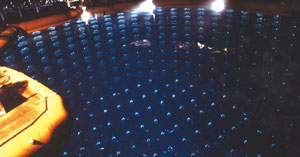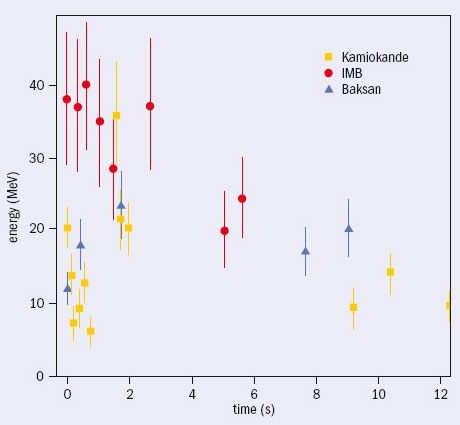In 1987, detectors recorded a neutrino pulse emitted by SN1987A. Masayuki Nakahata, who found the signal in Kamiokande, looks at the ongoing legacy of this historic event.
Twenty years ago researchers observed neutrinos from the supernova SN1987A – the first detection of neutrinos from beyond our solar system. Underground detectors are now waiting to study the explosion and neutrino properties of the next nearby supernova.

In the early 1980s scientists built the first big detectors underground to search for nucleon decays. Grand unified theories (GUTs), proposed in the late 1970s, unify strong, weak and electromagnetic interactions. They predict that quarks can be transformed to leptons and that even the lightest hadron, the proton, can decay to lighter particles, such as electrons, muons and pions. The predicted lifetime of the proton was then about 1030 years, inspiring the construction of detectors weighing several thousand tonnes. The Irvine–Michigan–Brookhaven (IMB) detector in the US, which started data-taking in 1982, was a Cherenkov detector with 7000 tonnes of water viewed by 2048 5-inch photomultiplier tubes (PMTs) (figure 1). It was soon followed by the Kamiokande water Cherenkov detector in Japan. This was a 3000 tonne detector with 1000 20-inch PMTs, and it started up in 1983 (figure 2). Unfortunately, these detectors could not detect a proton decay signal because the lifetime of the proton was ultimately predicted to be much longer than the early GUTs had indicated.
In 1984/5 the Kamiokande collaboration upgraded their detector to look for solar neutrinos. Previously, the only detector searching for solar neutrinos was the Homestake experiment of Ray Davis and colleagues. The experiment observed a solar-neutrino flux of about a third of that predicted by the standard solar model. This was the famous “solar-neutrino problem”, and further experiments were needed to solve the discrepancy. To detect solar neutrinos, the Kamiokande team installed new electronics to record the timing of each PMT. They also constructed an anticounter to reduce gamma rays from the rock and improved water-purification to reduce radon background. The IMB collaboration upgraded their 5 inch PMTs to 8 inch PMTs to lower the detector’s energy threshold.
Supernova!
On 23 February 1987 at 0735 (UT), when the Kamiokande detector was ready to detect solar neutrinos, it observed neutrinos from SN1987A. The progenitor of the supernova was a blue giant in the Large Magellanic Cloud, 170,000 light years away. The Kamiokande detector observed 11 events and the IMB detector registered eight. Researchers at the Baksan underground experiment in Russia later analysed their data for the same period and found five events. The neutrino burst observed lasted about 13 s (figure 3).

The theory of stellar evolution predicts that the final stage of a massive star (typically more than eight solar masses) is a core collapse followed by a neutron star or a black hole. As the temperature and density at the centre of stars increase, nuclear fusion produces heavier elements. This leads finally to an iron core of about one solar mass; further nuclear fusion is prevented as iron has the largest binding energy of all elements. When the core becomes gravitationally unstable it triggers the supernova explosion.
The gravitational potential energy of the iron core gives the energy released by the core collapse, which is about 3 × 1053 ergs. Predictions indicated that neutrinos would release most of the energy, since other particles, such as photons, are easily trapped by the massive material of the star. Researchers used the energy and number of observed events observed by Kamiokande and IMB to estimate the energy released by neutrinos from SN1987A, which was found to agree very well with expectations. This result confirmed the fundamental mechanism of a supernova explosion.

There has been extensive work to simulate the explosion of a supernova, taking into account the detailed nuclear physics and with the recent addition of multi-dimensional calculations. However, no simulation has produced an explosion. Something seems to be missing and further investigation and more experimental data are needed. Although the observation of neutrinos from SN1987A confirmed the supernova scenario, the observed number of events was too small to reveal details of the explosion.
The next event
More recent underground detectors will give very valuable information when the next supernova burst occurs. The Super-Kamiokande detector has a photo-sensitive volume of 32,000 tonnes viewed by 11,129 20-inch PMTs. It can detect about 8000 neutrino events if a burst occurs at the centre of our galaxy (a distance of about 10 kpc). Super-Kamiokande should be able to measure precisely the time variation of the supernova temperature by detecting the interactions of emitted antineutrinos on free protons. Neutrino–electron scattering events, which are about 5% of the total events, should pinpoint the direction of the supernova.

The kilotonne-class liquid-scintillator detectors, LVD in the Gran Sasso National Laboratory and KamLAND in Japan, will give additional information as they have a lower energy sensitivity and contain carbon. The IceCube detector, currently being built at the South Pole, can detect a supernova neutrino signal as a coherent increase of their PMT dark rate.
Although the supernova rate expected in our galaxy is only one every 20–30 years, a detection would provide an enormous amount of information. Scientists are proposing megatonne-class water Cherenkov detectors to detect proton decay and investigate neutrino physics, for example CP-violation in the lepton sector. If such detectors are built, they could observe a supernova in nearby galaxies every few years.
Supernovae have occurred throughout the universe since just after the Big Bang. The flux of all supernova neutrinos, known as supernova relic neutrinos (SRN), is intriguing. The expected flux of SRN is about several tens per square centimetre per second. The first five years of data from Super-Kamiokande gave an upper limit on the flux about three times higher than this expectation. By improving detection, it may soon be possible to detect SRN.
The neutrino data of SN1987A also yielded data on elementary-particle physics. It provided a limit on the mass of the neutrino of less than 20 eV/c2 (which in 1987 was competitive with laboratory experimental limits) and an upper limit on the neutrino lifetime. Future supernova data could provide something new in elementary-particle physics, for example, if the neutrino-mass hierarchy is inverted and a close supernova is detected, the energy spectrum of supernova neutrinos could reveal the hierarchy.
A conference to discuss supernova data from the past 20 years and what could be learned from a future supernova will be held at Waikoloa, Hawaii, on 23–25 February 2007.








